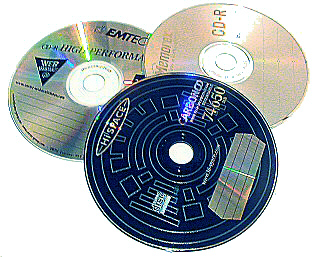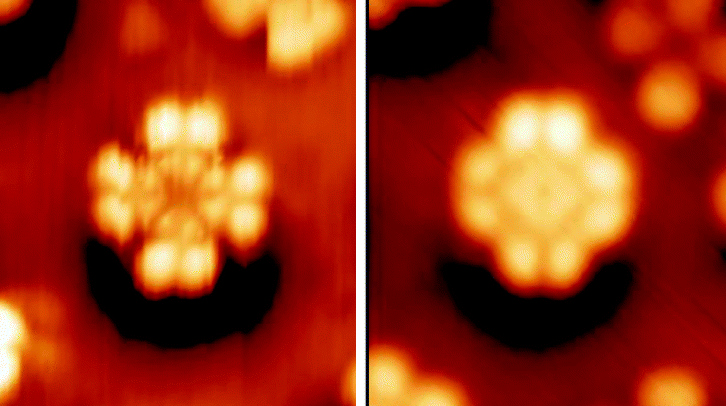|
Cyanine
Cyanines, also referred to as tetramethylindo(di)-carbocyanines are a synthetic dye family belonging to the polymethine group. Although the name derives etymologically from terms for shades of blue, the cyanine family covers the electromagnetic spectrum from infrared, near IR to ultraviolet, UV. Chemically, cyanines are a Conjugated system, conjugated system between two nitrogen atoms; in each resonance structure, exactly one nitrogen atom is oxidized to an iminium. Typically, they form part of a nitrogenous heterocycle, heterocyclic system. The main application for cyanine dyes is in Fluorescence microscopy, biological labeling. Nevertheless, there is a wide literature on both their synthesis and uses, and cyanines are common in some CD and DVD media. Structure Cyanines have been classified in many ways: * ''Streptocyanines'' or ''open chain cyanines'': : R2N+=CH[CH=CH]''n''-NR2 (I) * ''Hemicyanines'': : Aryl=N+=CH[CH=CH]''n''-NR2 (II) * ''Closed chain cyanines'': :Ar ... [...More Info...] [...Related Items...] OR: [Wikipedia] [Google] [Baidu] |
CD-R
CD-R (Compact disc-recordable) is a digital media, digital optical disc data storage device, storage format. A CD-R disc is a compact disc that can only be Write once read many, written once and read arbitrarily many times. CD-R discs (CD-Rs) are readable by most CD readers manufactured prior to the introduction of CD-R, unlike CD-RW discs. History Originally named CD Write once read many, Write-Once (WO), the CD-R specification was first published in 1988 by Philips and Sony in the Rainbow Books, Orange Book, which consists of several parts that provide details of the CD-WO, CD-MO (Magneto-Optic), and later CD-RW (Re Writable). The latest editions have abandoned the use of the term ''CD-WO'' in favor of ''CD-R'', while ''CD-MO'' was rarely used. Written CD-Rs and CD-RWs are, in the aspect of low-level encoding and data format, fully compatible with the audio CD (''Red Book'' CD-DA) and data CD (''Yellow Book'' CD-ROM) standards. The Yellow Book standard for CD-ROM only speci ... [...More Info...] [...Related Items...] OR: [Wikipedia] [Google] [Baidu] |
Polymethine
Polymethines are compounds made up from an ''odd'' number of methine groups (CH) bound together by alternating single and double bonds.Kachovski and Dekhtyar, ''Dyes and Pigments'', 22 (1983) 83-97. Compounds made up from an ''even'' number of methine groups are known as polyenes. Polymethine dyes Cyanines are synthetic dyes belonging to polymethine group. Anthocyanidins are natural plant pigments belonging to the group of the polymethine dyes. Polymethines are fluorescent dyes that may be attached to nucleic acid probes for different uses, ''e.g.'', to accurately count reticulocyte In hematology, reticulocytes are immature red blood cells (RBCs). In the process of erythropoiesis (red blood cell formation), reticulocytes develop and mature in the bone marrow and then circulate for about a day in the blood stream before dev ...s. References Alkenes {{alkene-stub ... [...More Info...] [...Related Items...] OR: [Wikipedia] [Google] [Baidu] |
Conjugated System
In physical organic chemistry, a conjugated system is a system of connected p-orbitals with delocalized electrons in a molecule, which in general lowers the overall energy of the molecule and increases Chemical stability, stability. It is Resonance (chemistry), conventionally represented as having alternating single and multiple covalent bond, bonds. Lone pairs, radical (chemistry), radicals or carbenium ions may be part of the system, which may be Cyclic molecule, cyclic, acyclic, Linear molecular geometry, linear or mixed. The term "conjugated" was coined in 1899 by the German chemist Johannes Thiele (chemist), Johannes Thiele. Conjugation is the orbital overlap, overlap of one p-orbital with another across an adjacent Sigma bond, σ bond (in transition metals, d-orbitals can be involved). A conjugated system has a region of overlapping p-orbitals, bridging the interjacent locations that simple diagrams illustrate as not having a π bond. They allow a delocalization of pi el ... [...More Info...] [...Related Items...] OR: [Wikipedia] [Google] [Baidu] |
Thiazole
Thiazole (), or 1,3-thiazole, is a 5-membered heterocyclic compound that contains both sulfur and nitrogen. The term 'thiazole' also refers to a large family of derivatives. Thiazole itself is a pale yellow liquid with a pyridine-like odor and the molecular formula C3H3NS. The thiazole ring is notable as a component of the vitamin thiamine (B1). Molecular and electronic structure Thiazoles are members of the azoles, heterocycles that include imidazoles and oxazoles. Thiazole can also be considered a functional group when part of a larger molecule. Being planar thiazoles are characterized by significant pi-electron delocalization and have some degree of aromaticity, more so than the corresponding oxazoles. This aromaticity is evidenced by the 1H NMR chemical shift of the ring protons, which absorb between 7.27 and 8.77 ppm, indicating a strong diamagnetic ring current. The calculated pi-electron density marks C5 as the primary site for electrophilic substitution, and C2-H ... [...More Info...] [...Related Items...] OR: [Wikipedia] [Google] [Baidu] |
Nucleic Acid
Nucleic acids are large biomolecules that are crucial in all cells and viruses. They are composed of nucleotides, which are the monomer components: a pentose, 5-carbon sugar, a phosphate group and a nitrogenous base. The two main classes of nucleic acids are deoxyribonucleic acid (DNA) and ribonucleic acid (RNA). If the sugar is ribose, the polymer is RNA; if the sugar is deoxyribose, a variant of ribose, the polymer is DNA. Nucleic acids are chemical compounds that are found in nature. They carry information in cells and make up genetic material. These acids are very common in all living things, where they create, encode, and store information in every living cell of every outline of life forms, life-form on Earth. In turn, they send and express that information inside and outside the cell nucleus. From the inner workings of the cell to the young of a living thing, they contain and provide information via the nucleic acid sequence. This gives the RNA and DNA their unmistakable 'la ... [...More Info...] [...Related Items...] OR: [Wikipedia] [Google] [Baidu] |
Azo Compound
Azo compounds are organic compounds bearing the functional group diazenyl (, in which R and R′ can be either aryl or alkyl groups). IUPAC defines azo compounds as: "Derivatives of diazene (diimide), , wherein both hydrogens are substituted by hydrocarbyl groups, e.g. azobenzene or diphenyldiazene.", where Ph stands for phenyl group. The more stable derivatives contain two aryl groups. The group is called an ''azo group'' (, ). Many textile and leather articles are dyed with azo dyes and pigments. Aryl azo compounds urinary tract infections">Phenazopyridine, an aryl azo compound, is used to treat urinary tract infections">150px Aryl azo compounds are usually stable, crystalline species. Azobenzene is the prototypical aromatic azo compound. It exists mainly as the Cis-trans isomerism, ''trans'' isomer, but upon illumination, converts to the Cis-trans isomerism, ''cis'' isomer. Aromatic azo compounds can be synthesized by azo coupling, which entails an electrophilic ... [...More Info...] [...Related Items...] OR: [Wikipedia] [Google] [Baidu] |
Phthalocyanine
Phthalocyanine () is a large, aromatic, macrocyclic, organic compound with the formula and is of theoretical or specialized interest in chemical dyes and photoelectricity. It is composed of four isoindole units linked by a ring of nitrogen atoms. = has a two-dimensional geometry and a ring system consisting of 18 π-electrons. The extensive delocalization of the π-electrons affords the molecule useful properties, lending itself to applications in dyes and pigments. Metal complexes derived from , the conjugate base of , are valuable in catalysis, organic solar cells, and photodynamic therapy. Properties Phthalocyanine and derived metal complexes (MPc) tend to aggregate and, thus, have low solubility in common solvents. Benzene at 40 °C dissolves less than a milligram of or CuPc per litre. and CuPc dissolve easily in sulfuric acid due to the protonation of the nitrogen atoms bridging the pyrrole rings. Many phthalocyanine compounds are, thermally, very s ... [...More Info...] [...Related Items...] OR: [Wikipedia] [Google] [Baidu] |
DVD-R
DVD recordable and DVD rewritable are a collection of optical disc formats that can be written to by a DVD recorder and by computers using a DVD writer. The "recordable" discs are write-once read-many (WORM) media, where as "rewritable" discs are able to be erased and rewritten. Data is written (" burned") to the disc by a laser, rather than the data being "pressed" onto the disc during manufacture, like a DVD-ROM. Pressing is used in mass production, primarily for the distribution of home video. DVD±R (also DVD+/-R, or "DVD plus/dash R") is a shorthand term for both DVD+R and DVD-R formats. Likewise, the term DVD±RW refers to both rewritable disc types, the DVD+RW and the DVD-RW. DVD±R/W (also written as, DVD±R/RW, DVD±R/±RW, DVD+/-RW, DVD±R(W) and other arbitrary ways) handles all common writable disc types, but not DVD-RAM. A drive that supports writing to all these disc types including DVD-RAM (but not necessarily including cartridges or 8cm diameter discs) is ref ... [...More Info...] [...Related Items...] OR: [Wikipedia] [Google] [Baidu] |
Panchromatic
A panchromatic emulsion is a type of photographic emulsion that is sensitive to all wavelengths of visible light, and produces a monochrome photograph—typically black and white. Most modern commercially available film is panchromatic, and the technology is usually contrasted with earlier methods that cannot register all wavelengths, especially orthochromatic film. In digital imaging, a panchromatic sensor is an image sensor or array of sensors that combine the visible spectrum with non-visible wavelengths, such as ultraviolet or infrared. Images produced are also black and white, and the system is used for its ability to produce higher resolution images than standard digital sensors. Description A panchromatic emulsion renders a realistic reproduction of a scene as it appears to the human eye, although with no colors. Almost all modern photographic film is panchromatic. Some older types of film were orthochromatic and were not sensitive to certain wavelengths of light. As ... [...More Info...] [...Related Items...] OR: [Wikipedia] [Google] [Baidu] |
Wavelength
In physics and mathematics, wavelength or spatial period of a wave or periodic function is the distance over which the wave's shape repeats. In other words, it is the distance between consecutive corresponding points of the same ''phase (waves), phase'' on the wave, such as two adjacent crests, troughs, or zero crossings. Wavelength is a characteristic of both traveling waves and standing waves, as well as other spatial wave patterns. The multiplicative inverse, inverse of the wavelength is called the ''spatial frequency''. Wavelength is commonly designated by the Greek letter lambda (''λ''). For a modulated wave, ''wavelength'' may refer to the carrier wavelength of the signal. The term ''wavelength'' may also apply to the repeating envelope (mathematics), envelope of modulated waves or waves formed by Interference (wave propagation), interference of several sinusoids. Assuming a sinusoidal wave moving at a fixed phase velocity, wave speed, wavelength is inversely proportion ... [...More Info...] [...Related Items...] OR: [Wikipedia] [Google] [Baidu] |
Photo Emulsion
Photographic emulsion is a light-sensitive colloid used in film-based photography. Most commonly, in silver-gelatin photography, it consists of silver halide crystals dispersed in gelatin. The emulsion is usually coated onto a substrate of glass, films (of cellulose nitrate, cellulose acetate or polyester), paper, or fabric. The substrate is often flexible and known as a film base. Photographic emulsion is not a true emulsion, but a suspension of solid particles (silver halide) in a fluid (gelatin in solution). However, the word ''emulsion'' is customarily used in a photographic context. Gelatin or gum arabic layers sensitized with dichromate used in the dichromated colloid processes carbon and gum bichromate are sometimes called ''emulsions''. Some processes do not have emulsions, such as platinum, cyanotype, salted paper, or kallitype. Components Photographic emulsion is a fine suspension of insoluble light-sensitive crystals in a colloid sol, usually consisting of gelat ... [...More Info...] [...Related Items...] OR: [Wikipedia] [Google] [Baidu] |




